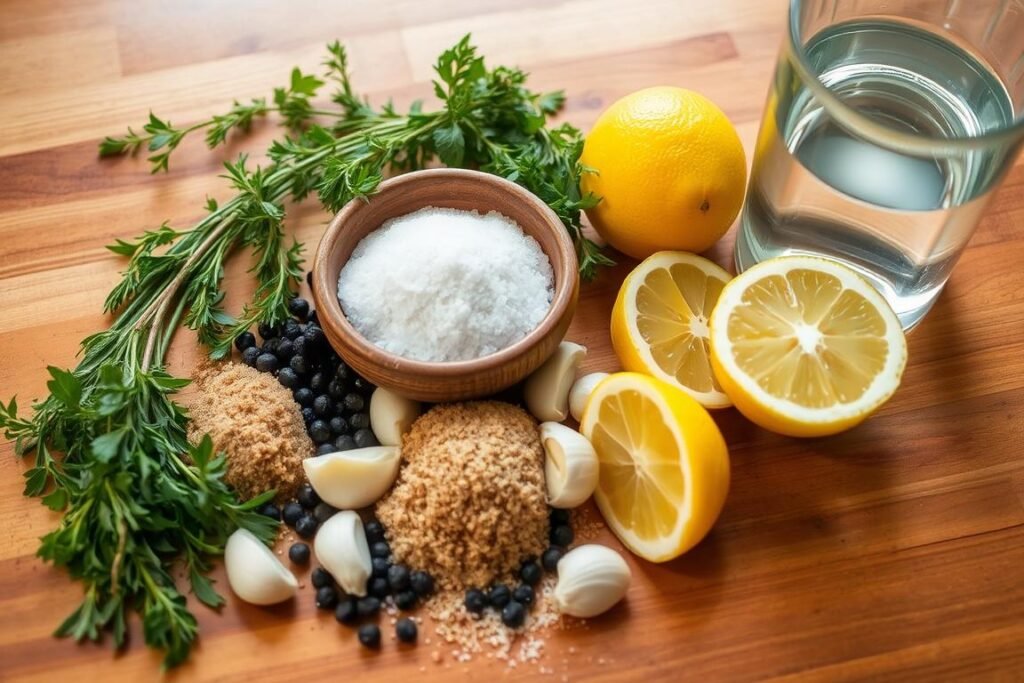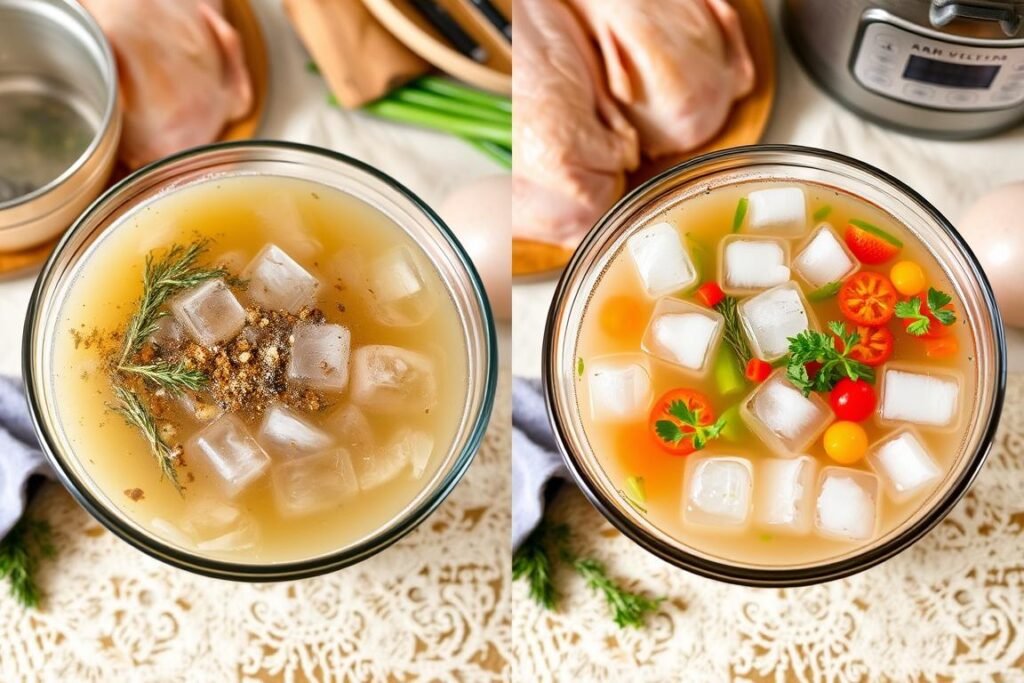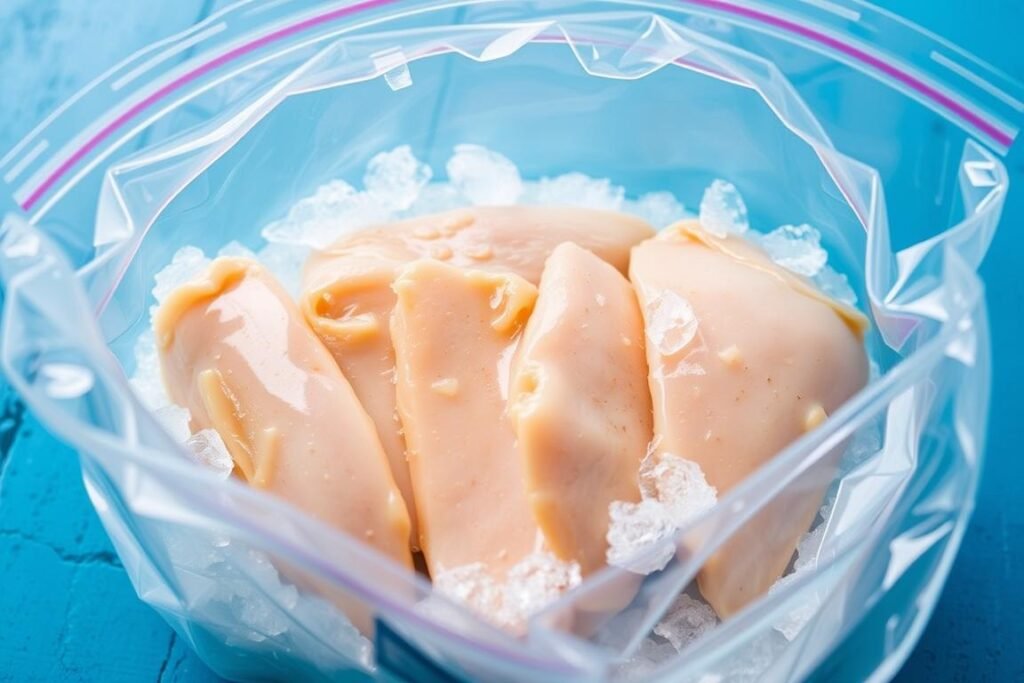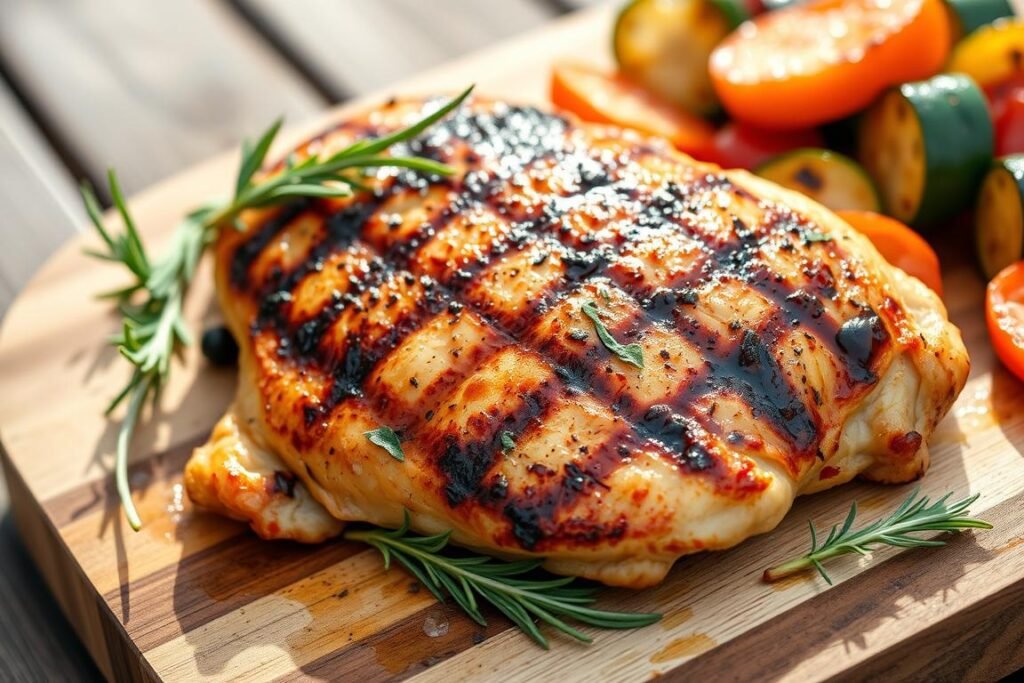Easy Chicken Breast Brine Recipe

Do you find boring, dry chicken breasts unacceptable? Brining is the key to tasty, tender, and juicy chicken. With this simple chicken breast brine recipe, your poultry will be a hit. But how does it work, and what is brewing?
Key Takeaways
- Brining entails immersing chicken in a saltwater solution to impart flavor and moisture.
- The brine preserves the natural fluids of the chicken breasts, therefore producing a more delicate and moist texture.
- Along with fragrant herbs and citrus to boost taste, this recipe calls for a basic 1:10 ratio of salt to water.
- Either brining at room temperature for thirty to sixty minutes or in the refrigerator for one to two hours yields the best results.
- After brining, rinsing the chicken helps eliminate any extra salt on the surface, thus guaranteeing a properly seasoned final meal.
What does brining involve and how does it operate?
Brining is a simple but powerful process that may change your chicken breasts into juicier, more tender, and delicious treats. This procedure includes soaking the chicken in a saltwater solution known as a brine before cooking. The salt in the brine helps the chicken’s muscle fibers to relax and expand, enabling them to retain more moisture throughout the cooking process.
Benefits of Brining Chicken Breasts
Brining your chicken breasts has a number of benefits that make it a game-changer in the kitchen:
- Improved Moisture Retention: The brine helps the chicken breasts absorb and retain more moisture, resulting in juicier and more tender flesh.
- Enhanced Flavor: The brine infuses the chicken with a mild, but delicious, flavor, improving the overall taste profile.
- Consistent Cooking: Brined chicken breasts are less prone to overcooking or drying out, delivering a more predictable and delightful culinary experience.
Knowing how brining works and the advantages it brings, you can unleash a whole new level of taste and texture in your chicken breasts, making them an absolute treat to savor.
| Nutritional Information (per serving) | Value |
|---|---|
| Calories | 264 kcal |
| Carbohydrates | 2 g |
| Protein | 48 g |
| Fat | 6 g |
| Saturated Fat | 1 g |
| Cholesterol | 145 mg |
| Sodium | 3751 mg |
| Potassium | 869 mg |
| Fiber | 1 g |
| Sugar | 1 g |
| Vitamin A | 81 IU |
| Vitamin C | 3 mg |
| Calcium | 22 mg |
| Iron | 1 mg |
Chicken Brine Ingredients
Making the ideal chicken brine is about blending the proper components. At its core, you need water, salt, and perhaps sugar. But you can make it even better by adding more flavors and aromatics.
The standard brine recipe utilizes 6 tablespoons of Diamond Crystal kosher salt, 4 1/2 teaspoons of Morton’s kosher salt, or 3 tablespoons of fine or table salt for 4 cups of cold water. This combination helps the chicken soak up just the proper amount of flavor without being overly salty.
You may also use other popular brine components, like:
- Garlic (smashed or minced)
- Whole peppercorns
- Fresh herbs (such as thyme, rosemary, or bay leaves)
- A small amount of granulated sugar (roughly 1/4 cup per 4 cups of water)
The idea is to allow the brine components to enhance the chicken’s aromatic qualities. This way, you get juicy, delicious chicken every time.

| Ingredient | Quantity |
|---|---|
| Water | 4 cups |
| Kosher Salt | 6 tablespoons (Diamond Crystal) or 4 1/2 tablespoons (Morton’s) |
| Granulated Sugar | 1/4 cup |
| Whole Peppercorns | 2 tablespoons |
| Garlic, smashed | 4 cloves |
Should Your Brine Be Warm or Cold?
Comparing Warm vs. Cold Brine
When brining chicken breasts, choosing the correct brine temperature is critical. Cold tap water is better than warm water. Cold water helps the brine distribute evenly, making the chicken soft and juicy.
Warm water might cause the chicken’s exterior layers to bulge. This prevents the brine from getting inside. Cold water, however, enables the brine to sink in better. This ensures the chicken is full of flavor and moisture.
Using warm water brine means your meal will contain a lot of salt, approximately 14,352.4 mg per serving. But a cold water brine contains just 234 mg of salt per serving. This makes the cold brine a healthier option.
| Brine Temperature | Sodium Content (mg/serving) | Texture and Juiciness |
|---|---|---|
| Warm Water Brine | 14,352.4 | Uneven distribution, risk of outer layers expanding |
| Cold Water Brine | 234 | Evenly distributed, more tender and juicy |
In conclusion, even though warm water is faster, cold water brine is best for chicken breasts. Cold water ensures that the flavors and moisture reach the meat effectively. This makes the chicken juicier and more delicious.

easy chicken breast brine recipe
Brining chicken breasts makes them tender and juicy. You only need a few ingredients for this easy chicken breast brine recipe. It’s great for adding flavor and moisture to your chicken dishes.
The basic brine ratio is 4 tablespoons (60 g) of salt for each quart (0.95 liters) of water. For a basic simple brine for chicken breasts, mix 4 cups of cold tap water with 4 1/2 tablespoons of Morton’s kosher salt or 3 tablespoons of fine or table salt. Stir until the salt dissolves. You can add 1 tablespoon of garlic granules for extra flavor. This homemade chicken brine recipe covers about 4 chicken breasts.
For a honey butter brine, use 2 tablespoons (30 g) of honey for each quart of water instead of sugar. To make a spicy brine, add jalapeno or habanero peppers, smoked paprika, garlic, and peppercorns to the basic mixture.
It’s important to let the chicken soak in the brine for the right amount of time. Chicken breasts should brine for 1 hour per pound. Larger cuts like whole chickens can brine overnight for the best flavor and tenderness.
How Long to Brine Chicken Breasts
Brining Times and Results
Brining chicken breasts is a simple way to make them moist and tasty. The optimal brining time is between 30 minutes and 1 hour. Brining for 15 minutes gives a slight salt taste but doesn’t significantly affect the texture.
Brining for 30 minutes makes the chicken a little more tender. But brining for 1 hour makes the chicken wonderfully seasoned, juicy, and tender. This demonstrates a considerable change in texture and softness.
Remember, brining for more than 2 hours might make the chicken overly salty. So, it’s preferable to keep brining for 30 minutes to 1 hour. The ideal brine time is roughly 1 hour. This helps the brine thoroughly sink into the chicken, boosting its natural tastes and juiciness.
- Brine for 15 minutes: a light salty taste with no apparent textural change.
- Brine for 30 minutes: slightly more tender chicken
- Brine for 1 hour: perfectly seasoned, juicy, and tender chicken breasts
- Brine for more than 2 hours: Chicken gets too salty
By following these brining timings, you’ll obtain the greatest brining chicken outcomes. Your boneless, skinless chicken breasts will be juicy, tasty, and a delight to eat.

Can You Freeze Brined Chicken Breasts?
Yes, you can freeze brined chicken breasts! Brining makes chicken soft and tasty. Freezing it is a clever way to keep it juicy and ready to eat at any time.
After brining the chicken, drain the brine and pat it dry. Then, place it in a freezer-safe container or bag. The brine converts into frozen water droplets in the flesh. This keeps the chicken moist and tender, even after it’s frozen.
It’s best to use frozen brined chicken within 6 months. Freezing it longer might make the chicken’s texture less ideal owing to ice crystals.
| Freezing Brined Chicken Breasts | Benefits |
|---|---|
| Drain excess brine and pat dry | Retains moisture and flavor |
| Store in freezer-safe container | Convenient meal prep option |
| Use within 6 months for best quality | Maintains tender, juicy texture |
If you’ve brined chicken and won’t use it all right away, freeze it. In this manner, you can freeze brined chicken, freeze brined chicken, and store brined chicken for later. It makes meal prep easier.

How to Cook Chicken Breasts After Brining
After brining your chicken breasts, it’s time to cook them correctly. Brined chicken is flexible—you can bake, grill, or sauté it. It will always be juicy and tasty.
Baking Brined Chicken Breasts
For brined chicken breasts, baking is straightforward and hands-off. Preheat your oven to 450°F. Pat the chicken dry with paper towels and season it as you prefer. Bake for 15-18 minutes, until it’s 165°F within. Let it rest for 5-10 minutes before slicing and serving.
Grilling Brined Chicken Breasts
Grilling imparts a wonderful char and smokey taste. Preheat your grill to medium-high heat. Make sure the grates are well-oiled. Grill the chicken for 15-18 minutes, turning halfway, until it’s 165°F inside. Let it sit for 5 minutes before slicing.
Choose your cooking technique carefully. Don’t rinse the chicken after brining. The brine has seasoned the meat, so rinsing will make it less tasty. Just pat the chicken dry and cook it how you prefer.
With these suggestions, you’ll have juicy, tasty brined chicken every time. For a fantastic dinner, serve it with your favorite sides.

Brining Tips and Tricks
Brining chicken breasts can make a big difference. But, there are some tips and tricks to get the best results. Let’s explore some expert advice to improve your brining skills.
Choosing the Right Salt
The salt you use in your brine is key to flavor. Choose kosher or pickling salt for better control. Table salt is too fine and can make the brine too salty.
Flavorful Additions
Be creative with your brine! Add herbs like rosemary, thyme, or parsley. Aromatics like garlic and lemon also add great flavor. Try different mixes to find your favorite.
Temperature and Time
Brine your chicken in the fridge, especially for longer times. This keeps it safe and prevents bacteria. For chicken breasts, brine for 30 minutes to 2 hours.
Cooking Adjustments
After brining, adjust your cooking times and temperatures. Brined chicken cooks faster. Use a meat thermometer to ensure it reaches 165°F (74°C).
“Brining is a simple technique that can transform ordinary chicken breasts into juicy, flavorful masterpieces. With a few expert tips, you’ll be well on your way to becoming a brining pro.”
Success in brining comes from balancing salt, time, and ingredients. Experiment, taste, and adjust until you get your perfect brined chicken.
Conclusion
Brining is a simple yet powerful technique that makes ordinary chicken breasts juicy and flavorful. By following the steps and guidelines in this guide, you can impress your family and friends. You’ll show off your culinary skills.
The main takeaways from this article are about the right brine ingredients and the best brining time. You’ll learn about the most effective cooking methods too. Whether you choose a warm or cold brine, or brine for 8 hours or more, your chicken will be tender and delicious.
Mastering brining lets you consistently make juicy, flavorful chicken breasts. This elevates any meal. So, try brining in your kitchen. Your taste buds and dinner guests will love it!
FAQ
What is brining and how does it work?
Brining is a method where you soak meat, like chicken breasts, in a salt water mix before cooking. This makes the chicken juicy, tender, and full of flavor.
What are the benefits of brining chicken breasts?
Brining relaxes the chicken’s muscle fibers, keeping it moist during cooking. It also adds a subtle flavor, making the chicken taste better.
What are the main ingredients in a chicken brine?
A basic chicken brine includes water and salt. You can also add garlic, herbs, peppercorns, or a bit of sugar for extra taste.
Should I use warm or cold water for the brine?
Always use cold tap water for brining. Warm water can make the chicken’s outer layers expand, stopping the brine from getting inside. Cold water ensures the brine spreads evenly.
What is the easy chicken breast brine recipe?
For an easy brine, mix 4 cups of cold water with 4 1/2 tablespoons of Morton’s kosher salt or 3 tablespoons of fine or table salt. Stir until the salt dissolves. Add 1 tablespoon of garlic granules for extra flavor.
How long should I brine chicken breasts?
Brine chicken breasts for 30 minutes to 1 hour for the best results. Brining for 15 minutes adds a light salt flavor. Brining for 30 minutes makes the chicken slightly tender. A 1-hour brine makes the chicken perfectly seasoned, juicy, and tender.
Can you freeze brined chicken breasts?
Yes, you can freeze brined chicken breasts. After brining for 30-60 minutes, drain the excess brine and freeze the chicken. The brine will stay in the meat as frozen water droplets. Use the frozen chicken within 6 months.
How should I cook chicken breasts after brining?
Cook the brined chicken breasts using your favorite method, like baking or grilling. Don’t rinse the chicken after brining. This won’t remove salt and can increase bacteria in your kitchen.
What are some additional tips and tricks for brining chicken breasts?
Use the right salt and add optional ingredients like garlic or herbs for more flavor. Refrigerate the chicken while brining. Don’t rinse the chicken after brining. Adjust cooking times and temperatures as needed for brined chicken.
Source Links
- How to Brine Chicken Breasts
- Chicken Breast Brine
- Quick Chicken Brine Recipe for Perfect Chicken Every Time
- The 1-Ingredient Secret to Juicy Chicken Breasts
- How to Make a Brine for Chicken
- How To Brine Chicken Breasts
- Brined and Baked Chicken Breasts
- Basic Chicken Brine
- Easy Brine (Grilled Chicken Breasts) Recipe
- How to Brine Chicken Breast
- Simple Chicken Brine
- How to Brine Chicken Breast: 9 Simple Steps
- The Juiciest Brined Grilled Chicken
- Chicken Brine Recipe
- Brined Chicken Breasts – Lisa G Cooks
- How To Brine Chicken Breasts
- JUICY BRINED CHICKEN BREAST RECIPE
- Baked Chicken Breast | Gimme Some Oven
- Learn my method for perfect oven baked chicken breasts every time!
- Homemade Brine Mix (The Secret to Perfect, Juicy Chicken)
- Chicken Brine – for the juiciest roast chicken of your life!
- Basic Sous Vide Chicken Breast: To Brine or Not to Brine?
- Exactly How I Brine and Grill My Chicken Breasts in Bulk – Heather’s Dish



2 Comments